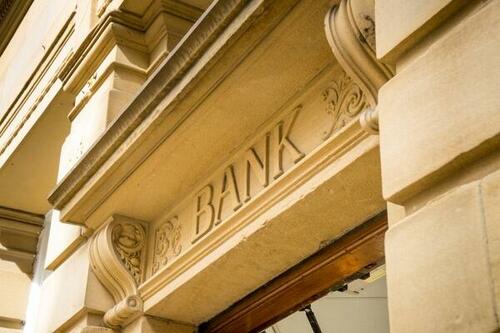
Authored by Nick Giambruno via InternationalMan.com,
Every day, there are over 2,000,000,000 consumer transactions around the world.
Visa, Mastercard, American Express, and other large companies process many of these payments.
Bitcoin, on the other hand, does not have anywhere near the capacity to handle this kind of volume.
There is a hard limit on the maximum number of transactions the Bitcoin network can process - about 576,000 transactions a day, or about 0.029% of all the world’s consumer transactions.
That’s why recording every Starbucks or McDonald’s transaction on the Bitcoin blockchain was never possible.
It was also never desirable.
If Bitcoin needed to record every consumer transaction on its blockchain—or even a fraction of them—it would require an industrial-scale operation with expensive data centers.
In that scenario, only large entities could run the Bitcoin software, and the average person would not be able to participate in enforcing the consensus parameters and the protocol.
That would kill Bitcoin’s decentralization because a few large entities would solely validate and enforce the protocol, which means they would be in charge.
In this scenario, Bitcoin might as well be another PayPal, Visa, or another centralized financial service where you need to ask for permission to do anything.
Remember, Bitcoin’s entire value proposition as a global money depends on being neutral, censorship-resistant, accessible to everyone, and controlled by nobody. To have these properties, it’s essential the average person can run the full Bitcoin software.
That’s why Bitcoin has a hard limit on the transactions it can handle each day. This limit is necessary so that the average computer—and soon the average smartphone—can easily run the full Bitcoin software. This is what makes Bitcoin genuinely decentralized and incorruptible, giving it unique monetary properties.
It’s crucial to emphasize that Bitcoin would be worthless without decentralization.
Scaling Bitcoin by compromising its decentralization would defeat its entire purpose.
Does that mean Bitcoin will never be able to scale and achieve widespread adoption?
Absolutely not.
Here’s the correct way to think of the situation…
Monetary Layers
When you use your credit card to buy a coffee at Starbucks, the money doesn’t land in Starbucks’ bank account when Visa approves the transaction.
Instead, a payment processor collects the money. It then aggregates a bunch of other transactions over a period. It then uses a commercial bank, which uses the Federal Reserve (the central bank of the US), to move the money from the payment processor’s bank account to Starbucks’ bank account for final settlement.
Aside from physical cash transactions, it’s not practical for Starbucks to immediately obtain final settlement. The company doesn’t have to clear with the Federal Reserve each cup of coffee it sells. Instead, it uses this layered approach with payment processors and banks to facilitate everyday transactions.
All successful financial systems have used a layered approach to scale, including the one based on a gold standard, the current fiat currency system, and now Bitcoin.
The key characteristic of Layer 1 financial transactions is finality. They represent the ability to perform irreversible transactions that can transcend borders.
In the current fiat currency system, Layer 1 involves the central bank clearing transactions for final settlement, like an international wire transfer.
Under a gold standard, the central banks of two nations used to settle balances between themselves with physical gold. Once Country A delivered the physical gold to a vault in Country B, there was final settlement.
Transactions on the Bitcoin blockchain are comparable to these. They represent final international settlement and clearance.
Consider the Federal Reserve’s Fedwire system, which processes and settles irrevocable transactions. Fedwire processes about 773,000 transactions each business day. There are about 251 business days a year, meaning Fedwire processes about 194 million transactions each year.
Bitcoin can process about 576,000 transactions each day and operates 24/7/365, which means it can process about 210 million transactions each year—roughly comparable to Fedwire.
In short, Layer 1 transactions are typical for high-value transactions that need security and finality. However, they are inappropriate for most consumer transactions—it’s unnecessary to use an international wire transfer to pay for a cup of coffee—which instead can happen on Layer 2.
Layer 2 transactions shouldn’t be compared to Layer 1 transactions—they’re totally different.
Layer 2 transactions involve systems built on top of Layer 1 that offer more convenience.
Using a credit card to pay for a cup of coffee is an example of a Layer 2 transaction. It involves a credit card company and a payment processor that enable convenient transactions on top of the Federal Reserve’s clearance for final settlement.
So, which Bitcoin transactions should be on Layer 1 and Layer 2?
Those are subjective decisions every individual must make.
The competitive free market for the scarce resource of space on the Bitcoin blockchain will decide its most efficient use and, thus, which transactions should be on Layer 1 or Layer 2.
In other words, whoever is willing to pay the transaction fee to the miners can have their transactions inscribed onto the Bitcoin blockchain (Layer 1).
Larger transactions that demand a high level of security will likely use the Bitcoin blockchain.
Smaller consumer transactions will probably use more convenient Layer 2 solutions, just like they do now and did under the gold standard.
The idea is to keep Bitcoin’s base layer secure and scale by building on top of it. It would make no sense to scale Bitcoin by compromising its Layer 1. That would be bad engineering.
Further, Bitcoin’s monetary properties depend on the credibility of its supply, which depends on its extreme resistance to change. Thus, changing the base layer to increase transaction throughput would have undermined Bitcoin’s monetary properties, demonstrating that someone can change it. If the base layer can be changed to accommodate more transaction throughput, it can also be changed to increase the supply.
Here’s the bottom line.
Bitcoin’s base layer could never process the world’s consumer transactions—and that’s not a problem.
It’s crucial to remember that Bitcoin is not merely a new way to make payments—like a competitor to PayPal or Venmo—or a new phone app. It’s something much more profound: a superior alternative to central banks.
In other words, Bitcoin is a revolutionary innovation for the base monetary layer, something that hasn’t happened since mankind discovered gold’s potential as money thousands of years ago. It’s a quantum leap forward compared to other base monetary layers because it cannot be monopolized.
Bitcoin provides a foundation for a new financial system that is decentralized, politically neutral, accessible to everyone, controlled by nobody, censorship-resistant, immutable, trustless, totally resistant to debasement, and not dependent on any third party.
The critical point is that Bitcoin makes the base monetary layer trustless and minimizes the trust required to run Layer 2 systems. That’s a revolutionary improvement over the current and previous monetary systems.
The amount of value Bitcoin Layer 2 solutions could unlock is mind-bending.
Many Layer 2 solutions for Bitcoin will inevitably emerge.
Today, the Lightning Network—an open, peer-to-peer network built on Bitcoin that allows for nearly instantaneous transactions and almost zero fees—is the most prominent.
Tomorrow, it could be Bitcoin banks and federations.
Bitcoin banks and federations have enormous potential as a layered solution to bring Bitcoin to everyone and usher in a new era of free market banking worldwide. I’ll provide more details in a future article.
Before I go any further, I must clarify something important.
Bitcoin banking is NOT competing with self-custody. It competes with other custodial solutions like Coinbase, ETFs, and the traditional banking system.
Bitcoin banks are not as good as self-custody but not as bad as holding your BTC in an exchange. They are somewhere in the middle. It’s a trade-off and a reasonable one for some people.
In any case, I strongly advocate Bitcoin self-custody so that you have total financial sovereignty over your money.
However, as Bitcoin continues its ascent to the world’s dominant money, it will become significantly more expensive to self-custody, pricing out many people. That’s an excellent reason not to delay learning to self-custody—I suggest doing it as soon as possible.
Consider life during the gold standard. You would have been among the most wealthy if you owned gold bullion bars—the base layer monetary asset at the time. Most people did not own them. Instead, they owned other things like gold-backed notes that banks issued.
If Bitcoin becomes the world’s dominant money one day, owning BTC in a self-custody wallet would be like owning gold bullion bars during the gold standard—something only available to institutions and the wealthy.
That’s why I’ve just released an urgent PDF report revealing three crucial Bitcoin techniques to ensure you avoid the most common—sometimes fatal—mistakes.
Check it out as soon as possible because it could soon be too late to take action. Click here to get it now.
Authored by Nick Giambruno via InternationalMan.com,
Every day, there are over 2,000,000,000 consumer transactions around the world.
Visa, Mastercard, American Express, and other large companies process many of these payments.
Bitcoin, on the other hand, does not have anywhere near the capacity to handle this kind of volume.
There is a hard limit on the maximum number of transactions the Bitcoin network can process – about 576,000 transactions a day, or about 0.029% of all the world’s consumer transactions.
That’s why recording every Starbucks or McDonald’s transaction on the Bitcoin blockchain was never possible.
It was also never desirable.
If Bitcoin needed to record every consumer transaction on its blockchain—or even a fraction of them—it would require an industrial-scale operation with expensive data centers.
In that scenario, only large entities could run the Bitcoin software, and the average person would not be able to participate in enforcing the consensus parameters and the protocol.
That would kill Bitcoin’s decentralization because a few large entities would solely validate and enforce the protocol, which means they would be in charge.
In this scenario, Bitcoin might as well be another PayPal, Visa, or another centralized financial service where you need to ask for permission to do anything.
Remember, Bitcoin’s entire value proposition as a global money depends on being neutral, censorship-resistant, accessible to everyone, and controlled by nobody. To have these properties, it’s essential the average person can run the full Bitcoin software.
That’s why Bitcoin has a hard limit on the transactions it can handle each day. This limit is necessary so that the average computer—and soon the average smartphone—can easily run the full Bitcoin software. This is what makes Bitcoin genuinely decentralized and incorruptible, giving it unique monetary properties.
It’s crucial to emphasize that Bitcoin would be worthless without decentralization.
Scaling Bitcoin by compromising its decentralization would defeat its entire purpose.
Does that mean Bitcoin will never be able to scale and achieve widespread adoption?
Absolutely not.
Here’s the correct way to think of the situation…
Monetary Layers
When you use your credit card to buy a coffee at Starbucks, the money doesn’t land in Starbucks’ bank account when Visa approves the transaction.
Instead, a payment processor collects the money. It then aggregates a bunch of other transactions over a period. It then uses a commercial bank, which uses the Federal Reserve (the central bank of the US), to move the money from the payment processor’s bank account to Starbucks’ bank account for final settlement.
Aside from physical cash transactions, it’s not practical for Starbucks to immediately obtain final settlement. The company doesn’t have to clear with the Federal Reserve each cup of coffee it sells. Instead, it uses this layered approach with payment processors and banks to facilitate everyday transactions.
All successful financial systems have used a layered approach to scale, including the one based on a gold standard, the current fiat currency system, and now Bitcoin.
The key characteristic of Layer 1 financial transactions is finality. They represent the ability to perform irreversible transactions that can transcend borders.
In the current fiat currency system, Layer 1 involves the central bank clearing transactions for final settlement, like an international wire transfer.
Under a gold standard, the central banks of two nations used to settle balances between themselves with physical gold. Once Country A delivered the physical gold to a vault in Country B, there was final settlement.
Transactions on the Bitcoin blockchain are comparable to these. They represent final international settlement and clearance.
Consider the Federal Reserve’s Fedwire system, which processes and settles irrevocable transactions. Fedwire processes about 773,000 transactions each business day. There are about 251 business days a year, meaning Fedwire processes about 194 million transactions each year.
Bitcoin can process about 576,000 transactions each day and operates 24/7/365, which means it can process about 210 million transactions each year—roughly comparable to Fedwire.
In short, Layer 1 transactions are typical for high-value transactions that need security and finality. However, they are inappropriate for most consumer transactions—it’s unnecessary to use an international wire transfer to pay for a cup of coffee—which instead can happen on Layer 2.
Layer 2 transactions shouldn’t be compared to Layer 1 transactions—they’re totally different.
Layer 2 transactions involve systems built on top of Layer 1 that offer more convenience.
Using a credit card to pay for a cup of coffee is an example of a Layer 2 transaction. It involves a credit card company and a payment processor that enable convenient transactions on top of the Federal Reserve’s clearance for final settlement.
So, which Bitcoin transactions should be on Layer 1 and Layer 2?
Those are subjective decisions every individual must make.
The competitive free market for the scarce resource of space on the Bitcoin blockchain will decide its most efficient use and, thus, which transactions should be on Layer 1 or Layer 2.
In other words, whoever is willing to pay the transaction fee to the miners can have their transactions inscribed onto the Bitcoin blockchain (Layer 1).
Larger transactions that demand a high level of security will likely use the Bitcoin blockchain.
Smaller consumer transactions will probably use more convenient Layer 2 solutions, just like they do now and did under the gold standard.
The idea is to keep Bitcoin’s base layer secure and scale by building on top of it. It would make no sense to scale Bitcoin by compromising its Layer 1. That would be bad engineering.
Further, Bitcoin’s monetary properties depend on the credibility of its supply, which depends on its extreme resistance to change. Thus, changing the base layer to increase transaction throughput would have undermined Bitcoin’s monetary properties, demonstrating that someone can change it. If the base layer can be changed to accommodate more transaction throughput, it can also be changed to increase the supply.
Here’s the bottom line.
Bitcoin’s base layer could never process the world’s consumer transactions—and that’s not a problem.
It’s crucial to remember that Bitcoin is not merely a new way to make payments—like a competitor to PayPal or Venmo—or a new phone app. It’s something much more profound: a superior alternative to central banks.
In other words, Bitcoin is a revolutionary innovation for the base monetary layer, something that hasn’t happened since mankind discovered gold’s potential as money thousands of years ago. It’s a quantum leap forward compared to other base monetary layers because it cannot be monopolized.
Bitcoin provides a foundation for a new financial system that is decentralized, politically neutral, accessible to everyone, controlled by nobody, censorship-resistant, immutable, trustless, totally resistant to debasement, and not dependent on any third party.
The critical point is that Bitcoin makes the base monetary layer trustless and minimizes the trust required to run Layer 2 systems. That’s a revolutionary improvement over the current and previous monetary systems.
The amount of value Bitcoin Layer 2 solutions could unlock is mind-bending.
Many Layer 2 solutions for Bitcoin will inevitably emerge.
Today, the Lightning Network—an open, peer-to-peer network built on Bitcoin that allows for nearly instantaneous transactions and almost zero fees—is the most prominent.
Tomorrow, it could be Bitcoin banks and federations.
Bitcoin banks and federations have enormous potential as a layered solution to bring Bitcoin to everyone and usher in a new era of free market banking worldwide. I’ll provide more details in a future article.
Before I go any further, I must clarify something important.
Bitcoin banking is NOT competing with self-custody. It competes with other custodial solutions like Coinbase, ETFs, and the traditional banking system.
Bitcoin banks are not as good as self-custody but not as bad as holding your BTC in an exchange. They are somewhere in the middle. It’s a trade-off and a reasonable one for some people.
In any case, I strongly advocate Bitcoin self-custody so that you have total financial sovereignty over your money.
However, as Bitcoin continues its ascent to the world’s dominant money, it will become significantly more expensive to self-custody, pricing out many people. That’s an excellent reason not to delay learning to self-custody—I suggest doing it as soon as possible.
Consider life during the gold standard. You would have been among the most wealthy if you owned gold bullion bars—the base layer monetary asset at the time. Most people did not own them. Instead, they owned other things like gold-backed notes that banks issued.
If Bitcoin becomes the world’s dominant money one day, owning BTC in a self-custody wallet would be like owning gold bullion bars during the gold standard—something only available to institutions and the wealthy.
That’s why I’ve just released an urgent PDF report revealing three crucial Bitcoin techniques to ensure you avoid the most common—sometimes fatal—mistakes.
Check it out as soon as possible because it could soon be too late to take action. Click here to get it now.
Loading…





